Features Added in FOCUS 7.7.06
The following features were added as of FOCUS 7.7.06.
x
With Excel 2007, Microsoft introduced enhanced worksheet
functionality in a new workbook file format. The XLSX format supports
most StyleSheet attributes, allowing for full report formatting.
The computer on which the report is being displayed must have Microsoft
Excel 2007 or higher installed.
The FOCUS procedure generates a new workbook
containing a single worksheet with the report output containing
your defined report elements (headings and subtotals), as well as
StyleSheet syntax:
- XLSX format accurately displays formatted numeric, character
and date formats.
- FORMAT XLSX FORMULA enables you to convert summed information
(such as column totals, row totals, and subtotals) and calculated
values into Excel formulas that will automatically update as you
edit the Excel worksheet.
- XLSX workbooks can contain embedded images in fixed positions
in each of the FOCUS report areas including headers, footers, and
data cells.
- Within each generated worksheet, the columns in the report are
automatically sized to fit the largest value in the column. FOCUS
calculates the width of each data column based on the font and size
requirement of all cells in that column using font metrics developed
for other styled formats, including PDF and DHTML. Calculations
are based on the data and title elements of the report. Heading
and footing elements are not used in the sizing calculation and
will be sized based on the data column requirements.
- Tab names within the workbook can be customized to provide better
descriptions of the worksheet content using the TITLETEXT StyleSheet
attribute
- By default, leading, internal, and trailing
blanks are compressed in cells within the worksheet.
- Font definitions for format XLSX in the fontuser.xml file can
be defined separately from other output formats, allowing ease in
customizing the look and feel of your XLSX workbooks. FOCUS uses
Arial as the default font. Use this feature to change the default font
to match the Microsoft Office standard font, Calibri, or your corporate standard.
x
Reference: Building the XLSX Workbook File
Microsoft
changed the format and structure of the Excel workbook in Excel
2007. The new .xlsx file is a binary compilation of a group of XML
files. Generating this new file format using FOCUS is a two step
process that consists of generating the XML files containing the
report output and zipping the XML documents into the binary .xlsx format.
The zipping process requires code included
in the webfocus.war file of the WebFOCUS client, which is deployed
as the ibi_apps context root on an application server such as Tomcat.
You must have an installed version of
the WebFOCUS Client so that ibi_apps is deployed. The application
server must be running when you issue the HOLD FORMAT XLSX command
in your report request. The WebFOCUS Client does not have to be
running. Your request must point to the URL where ibi_apps is deployed
using the SET EXCELSERVURL command:
SET EXCELSERVURL = http://servername:8080/ibi_apps
where:
- servername
Is the name of the machine where the application server is running.
- 8080
Is the default port used by the WebFOCUS Client to communicate
with the application server.
After the
XLSX output file is generated, you must FTP it to your PC in binary mode.
Example: Generating FORMAT XLSX FORMULA Output
The following request generates an XLSX
FORMULA output file. The host name for the machine on which the
application server is running is myserver.
DYNAM ALLOC DD HOLD DA USER1.HOLD.XLSX SHR REU
SET EXCELSERVURL = http://myserver:8080/ibi_apps
TABLE FILE GGSALES
SUM DOLLARS UNITS
BY CATEGORY
ON TABLE COLUMN-TOTAL
ON TABLE HOLD FORMAT XLSX FORMULA
END
The output is shown in the following
image. The Excel formula generated for the UNITS column-total is
shown in the formula field at the top of the Worksheet:
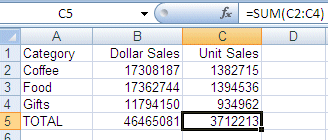
xMicrosoft PowerPoint Presentation File Format (PPTX)
The PPTX file format can contain reports, graphs, and
images with FOCUS styling features, as well as populate PowerPoint
templates containing preset Slide Masters, styling, and other business
content, as shown in the following image.
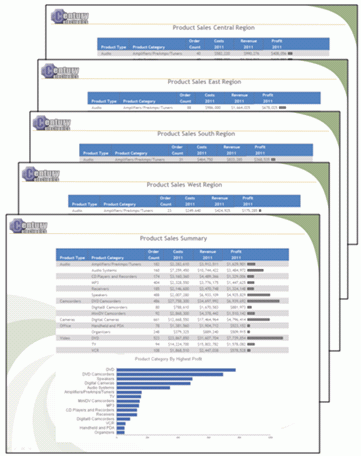
xUsing PowerPoint PPTX Display Format
With PowerPoint (PPTX), Microsoft® introduced enhanced
functionality in a new presentation file format.
The PPTX format generates fully styled
reports in binary display format, which uses the same binary technology
that is used for XLSX. When PPTX is specified as the output format, a
PowerPoint presentation with a single slide that includes the report
is created.
The FOCUS procedure generates a new presentation containing your
defined report elements, such as headings and subtotals, as well
as StyleSheet syntax, such as conditional styling and drill downs.
Additionally, you can add multiple graphs and images to a PowerPoint
presentation. The PowerPoint output format can contain a variety
of graphs positioned anywhere on a slide to create a visual layout.
x
Using PowerPoint PPTX Templates
You can place report output on a specific slide in a
PowerPoint template. This enables you to populate existing presentations
with preset Slide Masters, styling, and other business content.
x
Syntax: How to Create PowerPoint PPTX Report Output
ON TABLE {HOLD|SAVE} [AS name] FORMAT PPTX
[TEMPLATE {'template.potx'|'template.potm'} SLIDENUMBER n]
where:
- name
-
Is the name of the PowerPoint output
file.
- template
-
Is the name of the PowerPoint template
file. The template file must have at least one blank slide and must
be saved as a .POTX or .POTM extension.
Note: Since different extensions are
supported for PowerPoint templates, it is recommended that you include
the extension in the name of your template.
- n
-
Is the number of the slide on which to
place the report output. This number is optional if the template
has only one slide.
Example: Using a PowerPoint PPTX Template
The following request against the
GGSALES data source inserts a FOCUS report into a PowerPoint PPTX
template named mytemplate.potx which is stored in the application directory:
TABLE FILE GGSALES
HEADING
" "
" "
" "
" "
" "
SUM DOLLARS UNITS CATEGORY
BY REGION
ON TABLE SET PAGE-NUM NOLEAD
ON TABLE NOTOTAL
ON TABLE HOLD FORMAT PPTX TEMPLATE 'mytemplate.potx' SLIDENUMBER 3
ON TABLE SET HTMLCSS ON
ON TABLE SET STYLE *
TYPE=REPORT, FONT=ARIAL, SIZE=10,$
TYPE=HEADING, image=gglogo.gif, POSITION=(0.000000 0.000000),$
ENDSTYLE
END
The output
is:
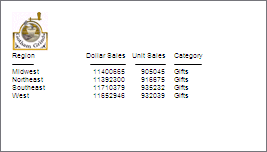
xEmbedded TrueType Font Support Enhancement
You can selectively embed a subset of Unicode (Arial
Unicode and MS Lucida Sans Unicode) or Non-Unicode (Tahoma, Times
New Roman, Trebuchet MS, and Courier New) TrueType fonts into a
PDF output file. The generated PDF file will contain only the characters
required to render the document.
xDisplaying Superscripts On Data, Heading, and Footing Lines
Superscript characters are supported as a text style
in text objects using HTML markup tags. The superscript markup tag
is now supported in data columns, headings, and footings in HTML,
PDF, and PS output formats. Superscript values can be defined within
the data, added to virtual fields, or added to text strings displayed
in headings and footings.
In order to activate the translation of the HTML markup tags,
in the StyleSheet set MARKUP=ON for any report component that will
display superscripts. Without this attribute, the markup tags will
be treated as text, not tags.
x
Syntax: How to Display Superscripts on Report Data, Heading, and Footing Lines
If
the tags are not within the data itself, create a field that contains
the text to be used as a superscript. Also, turn markup tags on
for the components that will display superscripts:
- In a DEFINE or COMPUTE command, define a field that contains
the text to be displayed as a superscript.
For a DEFINE FILE command,
the syntax is:
DEFINE FILE ...field/An = <sup>text</sup>;
END
For a COMPUTE command or a DEFINE in a Master
File, the syntax is:
{COMPUTE|DEFINE} field/An = <sup>text</sup>;where:
- field
Is the field to display with the superscript.
- n
Is the length of the string defining the superscript, including
the text to be used as the superscript and the opening and closing
markup tags (<sup> and </sup>).
- text
Is the text to be used as the superscript.
- In the StyleSheet, set MARKUP=ON for any report component that
will display superscripts:
TYPE=component,MARKUP=ON ... ,$
where:
- component
Is one of the following report components: DATA, HEADING,
FOOTING, SUBHEAD, SUBFOOT, TABHEADING, TABFOOTING.
Example: Displaying Superscripts in Data and Footing Lines in PDF Output
The following request against the GGSALES
data source defines two fields that will display as superscripts.
SUP1 and SUP2 consist of the numbers 1 and 2, respectively. SUPCOPY consists
of a copyright symbol. Note that the difference is the syntax defined
for a text value as opposed to a HEX value.
The COMPUTE command
compares sales dollars to budgeted dollars. If the value calculated
is less than a minimum defined, the superscript SUP1 is concatenated
after the category name. If the value is greater, SUP2 is concatenated.
The superscript SUPCOPY is used to display the copyright
symbol in the footing of the report.
The footing concatenates
the superscript fields in front of their explanations.
In
the StyleSheet, every component that will display a superscript
has the attribute MARKUP=ON.
DEFINE FILE GGSALES
SUP1/A12= '<SUP>1</SUP>';
SUP2/A15= '<SUP>2</SUP>';
SUPCOPY/A20= '<SUP>'||HEXBYT(169,'A2')||'</SUP>';
END
TABLE FILE GGSALES
SUM
COMPUTE PROFIT/D12CM=DOLLARS-BUDDOLLARS; NOPRINT
COMPUTE SHOWCAT/A100=IF PROFIT LE -50000 THEN CATEGORY || SUP1
ELSE IF PROFIT GT 50000 THEN CATEGORY || SUP2
ELSE CATEGORY; AS Category
BUDDOLLARS/D12CM
DOLLARS/D12CM
BY REGION
BY CATEGORY NOPRINT
HEADING
"Analysis of Budgeted and Actual Sales"
FOOTING
""
"<SUP1 Dollar sales $50,000 less than budgeted amount."
"<SUP2 Dollar sales $50,000 greater than budgeted amount."
""
"Copyright<SUPCOPY 2012, by Information Builders, Inc "
ON TABLE SET HTMLCSS ON
ON TABLE SET SQUEEZE ON
ON TABLE SET PAGE-NUM OFF
ON TABLE HOLD FORMAT PDF
ON TABLE SET STYLE *
INCLUDE=ENDEFLT,$
TYPE=DATA,MARKUP=ON,$
TYPE=DATA,COLUMN=N5, COLOR=RED, WHEN=PROFIT LT -50000,$
TYPE=DATA,COLUMN=N6, COLOR=GREEN, WHEN=PROFIT GT 50000,$
TYPE=HEADING, JUSTIFY=LEFT,$
TYPE=FOOTING, MARKUP=ON, JUSTIFY=LEFT,$
TYPE=FOOTING, LINE=2,JUSTIFY=LEFT, COLOR=RED,$
TYPE=FOOTING, LINE=3,JUSTIFY=LEFT, COLOR=GREEN,$
ENDThe output is:
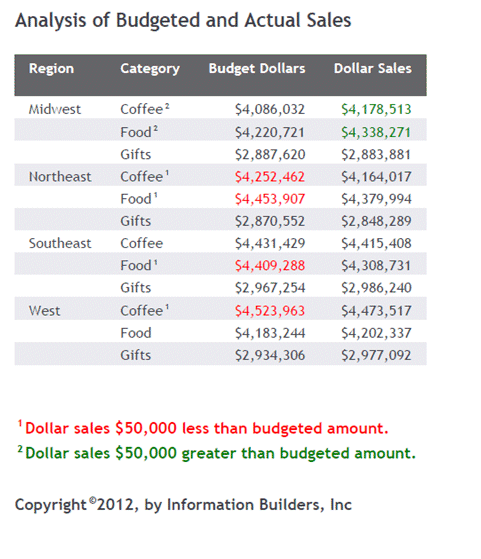
xROWOVERFLOW Enhancements for XLSX and EXL2K
The following enhancements have been added to the ROWOVERFLOW feature
that overcomes the Excel row limit for a Worksheet:
- ROWOVERFLOW is supported with XLSX report output.
- The new ROWLIMIT StyleSheet attribute sets the maximum number
of rows before the report overflows to a new Worksheet. The maximum
number of rows per Worksheet that you set will be an approximation
of the number of lines per page. The actual number of lines is also
dependent on the specific report components used in the request.
This attribute replaces the SET LINES command.
- The ROWOVERFLOW=PBON attribute includes internal FOCUS page breaks in EXL2K and
XLSX report output.
x
Overcoming the Excel 2003, 2007, and 2010 Row Limit Using Overflow Worksheets
The maximum number of rows supported by Excel 2003 on
a Worksheet is 65,536 (65K). The maximum number of rows supported
by Excel 2007 and 2010 on a Worksheet is 1,048,576 (1MB). When you
create an EXL2K or XLSX output file from a FOCUS report, the number of rows generated
can be greater than this maximum.
To avoid creating an incomplete output file, you can have extra
rows flow onto a new Worksheet, called an overflow Worksheet.
The name of each overflow Worksheet will be the name of the original
Worksheet appended with an increment number.
In addition, when the overflow Worksheet feature is enabled,
you can set a target value for the maximum number of rows to be
included on a Worksheet. By default, the row limit will be set to
the default value for the LINES parameter (57).
Note: By default, when generating EXL2K or XLSX output,
the FOCUS page
heading and page footing commands generate only Worksheet headings
and Worksheet footings.
x
Syntax: How to Enable Overflow Worksheets
Add the ROWOVERFLOW attribute to your FOCUS StyleSheet
TYPE=REPORT, ROWOVERFLOW={ON|OFF|PBON}, [ROWLIMIT={n|MAX}...where:
- ON
Enables overflow Worksheets.
- OFF
Disables overflow Worksheets. OFF is the default value.
- PBON
Inserts FOCUS page breaks
that display the page heading, footing, and column titles at the
appropriate places within the Worksheet rows. This option does not
cause a new Worksheet to start when a FOCUS
page break occurs.
- ROWLIMIT=n
Sets a target value for the number of rows to be included
on a Worksheet to n rows. The default value
is the LINES value (by default, 57).
- ROWLIMIT=MAX
Sets a target value for the number of rows to be included
on a Worksheet to 65,000 rows for EXL2K output or 1,048,000 rows
for XLSX output.
This attribute will work
only with EXL2K or XLSX output. For all other output types, the ROWOVERFLOW
StyleSheet attribute is ignored, and data flow is not affected.
x
Reference: Usage Notes for EXL2K and XLSX Overflow Worksheets
- The report heading is placed once at the start of the first
sheet. The report footing is placed once at the bottom of the last
overflow sheet.
- Unless the PBON setting is used, Worksheet headings and column
titles are repeated at the top of the original sheet and each subsequent
overflow sheet. Worksheet footings are placed at the bottom of the
original sheet and each subsequent overflow sheet. The data values
are displayed on the top data row of each overflow sheet as they
would be on a standard new page.
- Report total lines are displayed at the bottom of the last overflow
sheet directly above the final page and table footings.
- Subheadings, subfootings, and subtotal lines display within
the data flow as normal. No special consideration is made to retain
groupings within a given sheet.
- If ROWOVERFLOW=PBON, the page headings and footings and column
titles display within the Worksheet when a FOCUS
command causes a page break.
- For EXL2K output, if the ROWOVERFLOW attribute is specified
in the StyleSheet and ROWLIMIT is greater than 65K, the following
message is presented and no output file is generated:
(FOC3313) The row limit for EXL2K worksheets is 65536.
For
XLSX output, if the ROWOVERFLOW attribute is specified in the StyleSheet
and ROWLIMIT is greater than 1MB, the following message is presented
and no output file is generated:
(FOC3338) The row limit for EXCEL XLSX worksheets is 1048576.
- Output types that contain formula references (EXL2K PIVOT and
EXL2K FORMULA) are not supported, as formula references are not
automatically updated to reflect placement on new overflow worksheets.
- The overflow Worksheet feature applies to rows only, not columns.
A new Worksheet will not automatically be created if a report generates
more than the Excel 2003 limit of 256 columns or the Excel 2007/2010
limit or 16,384 columns.
- ROWOVERFLOW is supported for compound layout reports in EXL2K
and BYTOC reports for both EXL2K and XLSX.
- As named ranges in Excel cannot run across multiple Worksheets,
the IN-RANGES phrase that defines named ranges in the resulting
workbook is not supported with the ROWOVERFLOW feature. When they
exist together in the same request, ROWOVERFLOW takes precedence
and the IN-RANGES phrase is ignored.
Example: Creating Overflow Worksheets With EXL2K Report Output
The following request creates EXL2K
report output with overflow Worksheets. The ROWOVERFLOW=ON attribute
in the StyleSheet activates the overflow feature. Without this attribute,
one Worksheet would have been generated instead of three.
TABLE FILE GGSALES
-* ****Report Heading****
ON TABLE SUBHEAD
"SALES BY REGION, CATEGORY, AND PRODUCT"
" "
-* ****Worksheet Heading****
HEADING
"SALES REPORT WORKSHEET <TABPAGENO"
" "
-* ****Worksheet Footing****
FOOTING
" "
"END OF WORKSHEET <TABPAGENO"
PRINT DOLLARS UNITS BUDDOLLARS BUDUNITS
BY REGION
BY CATEGORY
BY PRODUCT
BY DATE
-* ****Subfoot****
ON REGION SUBFOOT
" "
" End of Region <REGION"
" "
-* ****Subhead****
ON REGION SUBFOOT
" "
" End of Region <REGION"
" "
-* ****Report Footing****
ON TABLE SUBFOOT
" "
"END OF REPORT"
ON TABLE HOLD FORMAT EXL2K
ON TABLE SET STYLE *
TYPE=REPORT, TITLETEXT=EXLOVER, ROWOVERFLOW=ON, ROWLIMIT=2000,$
ENDSTYLE
END
The report heading displays
on the first Worksheet only. The page heading and column titles
display on each Worksheet, and the subhead and subfoot display whenever
the associated sort field changes value. The following image shows
the top of the first Worksheet, displaying the report heading, page
heading, column titles, and first subhead.
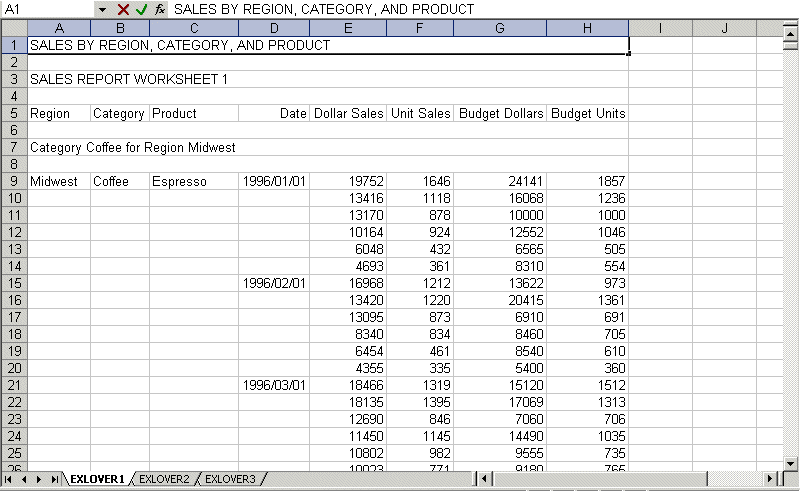
Note that the TITLETEXT
attribute in the StyleSheet specified the name EXLOVER, so the three
Worksheets were generated with the names EXLOVER1, EXLOVER2, and EXLOVER3.
If there had been no TITLETEXT attribute, the sheets would have
been named SHEET1, SHEET2, and SHEET3.
The
Worksheet footing displays at the bottom of each Worksheet and the
report footing displays at the bottom of the last Worksheet. The
following image shows the bottom of the last Worksheet, displaying
the last subfoot, the page footing, and the report footing.
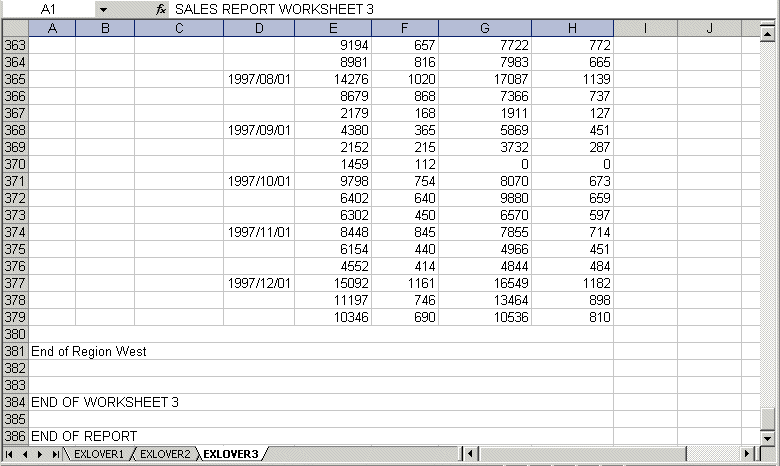
Example: Creating Overflow Worksheets With FOCUS Page Breaks
The following request creates XLSX report
output with overflow Worksheets. The ROWOVERFLOW=PBON attribute
in the StyleSheet activates the overflow feature, and the ROWLIMIT=250
sets the maximum number of rows in each Worksheet to approximately 250.
Without this attribute, one Worksheet would have been generated.
The PRODUCT sort phrase specifies a page break.
TABLE FILE GGSALES
-* ****Report Heading****
ON TABLE SUBHEAD
"SALES BY REGION, CATEGORY, AND PRODUCT"
" "
PRINT DOLLARS UNITS BUDDOLLARS BUDUNITS
BY REGION
BY HIGHEST CATEGORY
BY PRODUCT PAGE-BREAK
BY DATE
WHERE DATE GE '19971001'
-* ****Page Heading****
HEADING
" Product: <PRODUCT in Category: <CATEGORY for Region: <REGION"
-* ****Page Footing****
FOOTING
" "
-* ****Report Footing****
ON TABLE SUBFOOT
" "
"END OF REPORT"
ON TABLE SET BYDISPLAY ON
ON TABLE HOLD FORMAT XLSX
ON TABLE SET STYLE *
INCLUDE=endeflt,TITLETEXT=EXLOVER, ROWOVERFLOW=PBON, ROWLIMIT=250,
$
ENDSTYLE
END
The report heading displays
on the first Worksheet only. The page heading, footing, and column
titles display on each Worksheet and at each FOCUS
page break (each time the product changes), and the subhead and
subfoot display whenever the associated sort field changes value.
The following image shows the top of the first Worksheet.
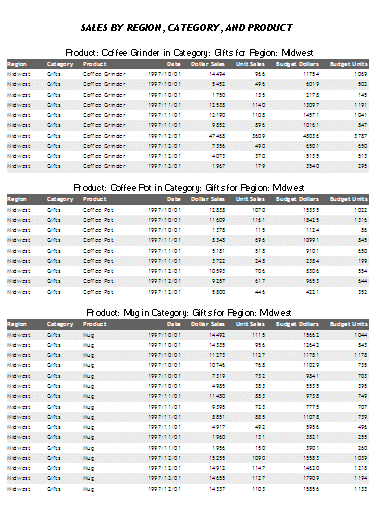
xUsing EXL2K Formula With Prefix Operators
EXL2K FORMULA output supports
prefix operators that are used on summary lines generated by FOCUS commands, such as SUBTOTAL
and RECOMPUTE. Where a corresponding formula exists in Excel, these
prefix operators are translated into the equivalent Excel summarization
formula. The results of prefix operators used directly against retrieved
data continue to be passed to Excel as values, not formulas.
The following table identifies the prefix
operators supported by EXL2K FORMULA when used on summary lines,
and the Excel formula equivalent placed in the generated worksheet.
|
Prefix Operator
|
Excel Formula Equivalent
|
|---|
|
SUM.
|
=SUM()
|
|
AVE.
|
=AVERAGE()
|
|
CNT.
|
=COUNT()
|
|
MIN.
|
=MIN()
|
|
MAX.
|
=MAX()
|
The following prefix operators are not
translated to formulas when used on summary lines in EXL2K FORMULA.
Note:
- When using a prefix operator on a field specified directly
against retrieved data, there is no space between the prefix operator
and the field on which it operates.
For
example, in the following aggregating display command, the AVE.
prefix operator operates on the DEALER_COST field:
SUM AVE.DEALER_COST
- When using a prefix operator on a summary line, you must leave
a space between the prefix operator and the aggregated field on
which it operates.
In the following summary
command, the MAX. prefix operator operates on the DOLLARS field
at the REGION sort break. Note the required blank space between
the prefix operator and the field name:
ON REGION RECOMPUTE MAX. DOLLARS
Example: Using a Summary Prefix Operator With Format EXL2K FORMULA
In the following request against the
GGSALES data source, the RECOMPUTE command for the REGION sort field
calculates the maximum of the aggregated DOLLARS field and the minimum
of the aggregated BUDDOLLARS field:
TABLE FILE GGSALES
SUM UNITS DOLLARS BUDDOLLARS
AND COMPUTE DIFF/I10= DOLLARS-BUDDOLLARS;
BY REGION
BY CATEGORY
WHERE CATEGORY EQ 'Food' OR 'Coffee'
WHERE REGION EQ 'West' OR 'Midwest'
ON REGION RECOMPUTE MAX. DOLLARS MIN. BUDDOLLARS DIFF
ON TABLE HOLD FORMAT EXL2K FORMULA
END
On the output, the cell
that represents the recomputed DOLLARS for the Midwest region has
been generated as the formula =MIN(E2:E3).
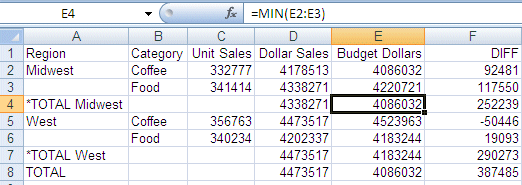
xStyling Tags for SUBTOTAL and GRANDTOTAL Lines
The tag is the text that is displayed
in the leftmost portion of each SUBTOTAL and GRANDTOTAL row in a
report. The tag is used to identify the type of data represented
within this row. The text used to generate this tag can be customized
by adding an AS name to the SUBTOTAL syntax.
You can define styling for the subtotal and grand total tag separately
from the rest of the row. Text attributes available for the tag,
including font, color, size, and style, can be used to differentiate
and highlight the tags. Additionally, styling can be applied that
turns tags into drill-down links.
Styling is supported for text attributes only. Cell or column
features such as borders, background color, or justification are
not supported.
This feature is available for PDF, DHTML, PS, HTML, AHTML, XLSX,
and EXL2K formats.
x
Syntax: How to Style Subtotal and Grand Total Tags
TYPE={SUBTOTAL|GRANDTOTAL}, OBJECT=TAG,
[FONT=font], [SIZE=size], [STYLE=style],
[COLOR={color|RGB({r g b|#hexcolor})],
[drilltype=drillparms], $where:
- font
Is the name of the font.
- size
Is the point size of the font.
- style
Is the font style, for example, bold, italic, or bold+italic.
- color
Is a color name.
- r g b
Specifies the font color using a mixture of red, green, and
blue.
(r g b) is the desired intensity of red, green, and
blue, respectively. The values are on a scale of 0 to 255, where
0 is the least intense and 255 is the most intense. Note that using
the three color components in equal intensity results in shades
of gray.
- #hexcolor
Is the hexadecimal value for the color. For example, FF0000
is the hexadecimal value for red. The hexadecimal digits can be
in uppercase or lowercase and must be preceded by a pound sign (#).
- drilltype
Is any valid drill-down attribute, for example, URL=. For
information about drill-down links, see the Creating Reports manual.
- drillparms
Are valid attribute values for the type of drill down.
Example: Styling SUBTOTAL and GRANDTOTAL Tags
The following request against the GGSALES
data source generates subtotal and grand total rows. The tags for
the subtotal rows are in italics and are white. The tag for the
grand total row has a drill-down link to a URL:
TABLE FILE GGSALES
SUM UNITS/D8C DOLLARS/D12CM BUDUNIT/D8C BUDDOLLARS/D12CM
BY REGION
BY CATEGORY
ON REGION SUBTOTAL
HEADING
"Gotham Grinds Sales Report"
ON TABLE SET HTMLCSS ON
ON TABLE HOLD FORMAT PDF
ON TABLE SET DROPBLNKLINE ALL
ON TABLE SET PAGE-NUM OFF
ON TABLE SET STYLE *
INCLUDE=ENDEFLT,$
TYPE=SUBTOTAL, OBJECT=TAG,STYLE=ITALIC,COLOR=WHITE,$
TYPE=GRANDTOTAL, BACKCOLOR='LIGHT GREY',$
TYPE=GRANDTOTAL, OBJECT=TAG,URL='http://www.informationbuilders.com',$
ENDSTYLE
END
The output is:
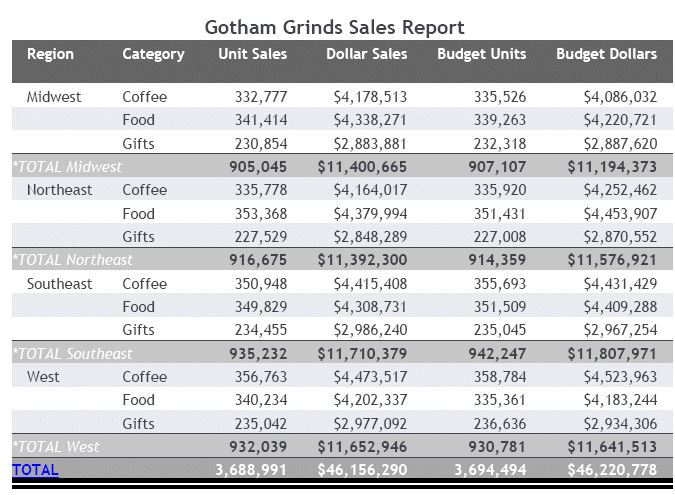
xConditional Styling Based on ACROSS Values
FOCUS supports using
ACROSS values to define conditional styling within the report. ACROSS
values can now be used as part of the conditional expressions used
to define styling attributes for each cell in the table.
Example: Conditionally Styling an ACROSS Value
The
example below demonstrates how the ACROSS value can be referenced
using either the ACROSS field name or the ACROSS column designator
(A1, A2).
In this example, the ACROSS
values are used in conditional styling to set a unique backcolor
for all ACROSS columns in the Category Coffee, and additional font
styling for the Espresso ACROSS column.
SET ACROSSTITLE=SIDE
TABLE FILE GGSALES
SUM DOLLARS/I8M AS ''
BY REGION
BY ST
BY CITY
ACROSS CATEGORY
ACROSS PRODUCT
WHERE CATEGORY EQ 'Coffee' OR 'Food';
ON TABLE SET PAGE-NUM NOPAGE
ON TABLE NOTOTAL
ON TABLE HOLD FORMAT PDF
ON TABLE SET HTMLCSS ON
ON TABLE SET STYLE *
SQUEEZE=ON,UNITS=IN,ORIENTATION=PORTRAIT,$
TYPE=REPORT,FONT='ARIAL',SIZE=10,BORDER=LIGHT,$
TYPE=ACROSSTITLE,COLOR=WHITE, BACKCOLOR=GREY,$
TYPE=ACROSSVALUE,COLOR=WHITE, BACKCOLOR=GREY,$
TYPE=TITLE,COLOR=WHITE, BACKCOLOR=GREY,$
TYPE=DATA, ACROSSCOLUMN=DOLLARS, BACKCOLOR=THISTLE, WHEN=CATEGORY EQ 'Coffee',$
TYPE=DATA, ACROSSCOLUMN=DOLLARS, STYLE=BOLD+ITALIC, WHEN=A2 EQ 'Espresso', $
ENDSTYLE
END
The output is:
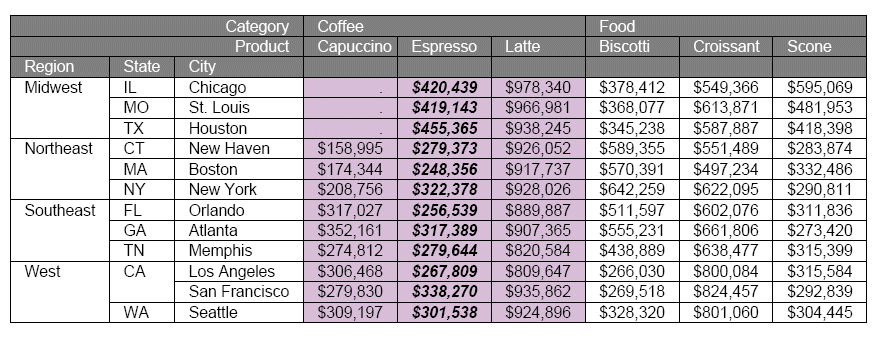
xSET ACROSSTITLE=SIDE Enhancements
The SET ACROSSTITLE=SIDE command:
- Is supported for HTML, EXL2K, and XLSX report output. In
prior releases, only PDF report output was supported.
- Supports the BACKCOLOR StyleSheet attribute for the ACROSS titles.
Example: Creating an ACROSSTITLE=SIDE Report With XLSX Report Output
The following request against the GGSALES
data source places the ACROSS titles next to the ACROSS values and
holds the output in XLSX format.
SET ACROSSTITLE=SIDE
TABLE FILE GGSALES
SUM
DOLLARS/I8M AS ''
BY REGION
BY ST
BY CITY
ACROSS CATEGORY
ON TABLE SET PAGE-NUM NOPAGE
ON TABLE NOTOTAL
ON TABLE HOLD FORMAT XLSX
ON TABLE SET HTMLCSS ON
ON TABLE SET STYLE *
UNITS=IN, SQUEEZE=ON, ORIENTATION=PORTRAIT, $
TYPE=REPORT, FONT='ARIAL', SIZE=10, BORDER=LIGHT,$
ENDSTYLE
END
On the output, the ACROSS
title CATEGORY displays to the left of its ACROSS values.

Example: Specifying Background Color for ACROSS Values With ACROSSTITLE=SIDE
The following request against the GGSALES
data source places the ACROSS titles next to the ACROSS values and
sets matching styling of font color and backcolor for the ACROSSTITLES,
ACROSSVALUES, and column titles to white text on grey background color.
SET ACROSSTITLE=SIDE
TABLE FILE GGSALES
SUM DOLLARS/I8M AS ''
BY REGION
BY ST
BY CITY
ACROSS CATEGORY
ACROSS PRODUCT
WHERE CATEGORY EQ 'Coffee' OR 'Food';
ON TABLE SET PAGE-NUM NOPAGE
ON TABLE NOTOTAL
ON TABLE HOLD FORMAT HTML
ON TABLE SET HTMLCSS ON
ON TABLE SET STYLE *
SQUEEZE=ON,UNITS=IN,ORIENTATION=PORTRAIT,$
TYPE=REPORT,FONT='ARIAL',SIZE=10,BORDER=LIGHT,$
TYPE=ACROSSTITLE,COLOR=WHITE, BACKCOLOR=GREY,$
TYPE=ACROSSVALUE,COLOR=WHITE, BACKCOLOR=GREY,$
TYPE=TITLE,COLOR=WHITE, BACKCOLOR=GREY,$
ENDSTYLE
END
The output has a grey
background color and white text for the ACROSS titles, ACROSS values,
and column titles.

xReading a Field Containing Delimited Values as individual Rows
A field that contains a list of delimited values (such
as email addresses separated by spaces) can now be pivoted to be
read as individual rows when an additional segment is added with
SEGSUF=DFIX (Delimited Flat File).
Previously, once the segment was added, it was not possible to
change the row or record delimiter. Now they can be edited.











